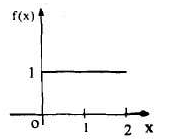Unit-2
Transforms
Question-1: Using complex form find the Fourier series of the function f(x) = x2, defined on the interval [-1,1]
Solution:
Here the half-period is L=1.Therefore, the coefficient c0 is,

For n

Integrating by parts twice,we obtain

= 
= 
= .
.
=  .
.
Question-2: Find the fourier integral representation of the function

Solution:
The graph of the function is shown in the below figure satisfies the hypothesis of
Theorem -1 . Hence from Eqn,(5) and (6), we have





Substituting these coefficients in Eqn.(4) we obtain




This is the Fourier integral representation of the given function.
Question-3: Find the Fourier integral representation of the function

Solution:
The graph of the given function is shown in the below figure . Clearly, the given function f(x) is an even function. We represent f(x) by the fourier cosine integral . We obtain




And thus ,

Question-4: Find the Fourier cosine integral of  , where x>0, k>0 hence show that
, where x>0, k>0 hence show that

Solution:
The Fourier cosine integral of f(x) is given by:





Question-5: Find the Fourier transform of 
Sol. As we know that the Fourier transform of f(x) will be-

So that-


Now put 

So that-

Question-6: Find the Fourier sine transform of 
Sol. Here x being positive in the interval (0, ∞)

Fourier sine transform of  will be-
will be-


Question-7: Find the Fourier sine transform of 
Sol. Let 
Then the Fourier sine transform will be-

Now suppose,

Differentiate both sides with respect to x, we get-
 ……. (1)
……. (1)
On integrating (1), we get-

Question-8: Find the Fourier transform of-

Hence evaluate 
Sol. As we know that the Fourier transform of f(x) will be-

So that-

For s = 0, we get- F(s) = 2
Hence by the inverse formula, we get-

Putting x = 0, we get

So-

Question-9: Find the Fourier cosine transform of-

Sol. We know that the Fourier cosine transform of f(x)-

= 
= 
= 
Question-10: Find Z-transform of the following functions-
(i) 
(ii) 
Sol.(i) 


(ii) 

Question-11: 
Solution:
Long division method to obtain 
 2
2





Now x(z) can be written as,
X(z) = 2-
Question-12: Solve the differential equation  by the z-transformation method.
by the z-transformation method.
Solution:
Given,

Let y(z) be the z-transform of 
Taking z-transforms of both sides of eq(1) we get,

ie. 
using the given condition,it reduces to
(z+1)y(z) = 
Ie.
Y(z) = 
Or Y(Z) = 
On taking inverse Z-transforms, we obtain
